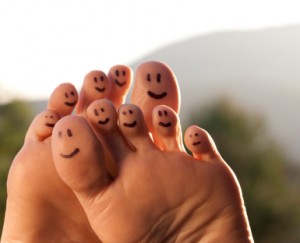Blisters form from a combination of moisture and friction. Moisture builds from sweat and the elements (rain) while friction stems from a sock or shoe rubbing against your skin. Here are three easy ways to prevent blisters from ruining your next run.
- If the shoe fits… The key to prevention blisters from happening is to start by getting fitted for walking or running shoes. It is common to go with your casual shoe size when picking out athletic shoes, but that formula can leave you with ill-fitting shoes, sore feet and blisters. Shop at your local walking or running specialty store to get properly fitted for shoes that will support your feet and your goals. They should watch you walk in the shoes and their should be at least a thumb’s width of space between your longest toe and the end of toe box (front of the shoe). It will make all the difference on your journey.
- Sock it to ‘em. While you’re at the store invest in a pair of socks that wick the moisture away from your skin. You can also order them online – my go-to socks these days are Drymax. You may also find great benefit with Injinji socks (toe socks) since your blisters are forming on your toes. Injinji socks provide a sock layer around each toe to prevent friction between your piggies. They take a little longer to put on, but they are well worth the effort.
- Bag it. If you’re still having blister problems consider lathering your feet with an inexpensive blister-relief product like Bag Balm or Body Glide. I lathered my feet with Bag Balm while racing in the Eco-Challenge in the wet jungles of Fiji and never had a blister. It works like a charm as it creates a waterproof seal between your skin and the sock and moisturizes your feet while you’re on the move!
If none of these strategies work, consider seeking advice from a foot doctor who can better evaluate what may be causing them. You should also review your training plan as increasing mileage too quickly can cause wear and tear on your body, including your feet.
If you do develop a blister, remember the safest way to address it is to use a sterilized needle to drain it and cover with a band-aid to prevent infection.




Appreciation to my father who shared with me concerning this website, this blog is really amazing.
[…] https://www.jennyhadfield.com/blister-prevention-for-runners/ […]
[…] Three Simple Steps to Blister Prevention for Runners … – Three Simple Steps to Blister Prevention for Runners. … Blisters form from a combination of moisture and friction. … (rain) while friction … […]